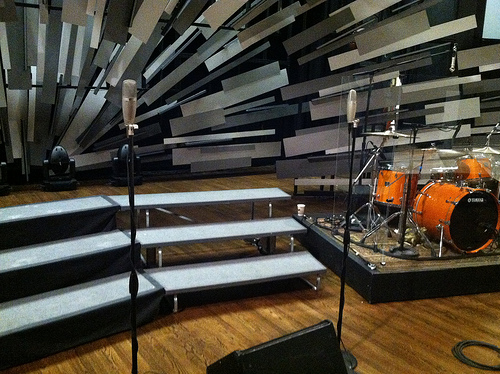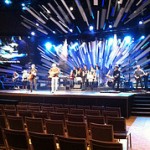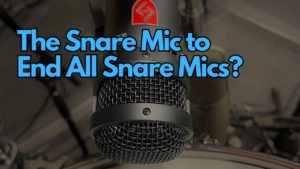
Happiness is a Warm Choir: Part 2
In my last post, I talked a bit about my philosophical approach to mixing choirs lately. Today I’ll get into the technicalities of it all.
Capturing the choir was the first challenge. For the first experiment with this our music department recorded some choir tracks that were fed to FOH as a stereo pair. I augmented these with a couple of KSM44’s on the live choir. I knew the mics would be a challenge regardless of how loud the choir sang because from a logistics standpoint the choir risers needed to go center-stage smack between our keys and drum risers, and the choir was a mini-choir of only about 20 or so people. But this is where my approach helped out.
I didn’t want to rely solely on tracks because that seemed like a copout so I took a slightly different mic’ing approach. Instead of aiming the mic closest to the drums at the choir, I positioned it to put the center of the kit 90 degrees off-axis from the mic. Ideally I would have liked to get the drums even more in the null of the mic, but that was about as far as I felt comfortable with in order to still aim at the choir. Fortunately, this actually helped out in putting some actual voices in the mic instead of simply drum bleed.
Another thing that helped in mic’ing the choir was my overall vision for the choir mics in the mix. Since I was thinking of quasi-audience mics, bleed into the mics wasn’t entirely bad. I even started thinking of the mics as drum-room mics at times as well, although, I knew that would limit how much of the mics I could use because I wanted to keep the drums relatively punchy. The compromise was a good bit of EQ on the mics to accentuate the mid-range voices and demphasize the drums in the mics as much as possible.
Next up was treating the vocal tracks. The first thing I did was throw these into a verb. Part of this was to help them sit a little better with the mics on stage, but it was also to give it more of a room vibe than pure choir. I started out trying to use more wet vocals than dry, but in the end settled on more dry vocal to maintain clarity. The final blend of choir tracks to choir mics was about a 50:50 split leaning a hair more towards the choir tracks.
The tracks and choir mics were then assigned to a single VCA so I could ride them as needed. Since the first couple times out was kind of a moving target and I didn’t know exactly what I’d get from the mics, I would set the VCA so that unity was a couple dB below feedback. That gave me an easy reference for when I was approaching the limit for the mics.
The best experience I’ve had so far with our choirs was our Night of Worship in February where I tried out the Microbooms. We had a large riser center stage between our drum and keys risers and then we had a smaller riser on the outside of the drums and another on the outside of the keys. The big riser held around 20-25 people and the small ones were in the 9-12 range. The riser on the outside of the keys was the farthest from the drums so I asked our music department to be strategic and place their strongest voices on that riser. The next strongest voices went just inside of the keys riser, and then the rest were spread across the other risers.
I had three pairs of microphones that night: 2 pairs of Audix Microbooms on loan from my friend Dustin Whitt over at Free Chapel and a pair of our KSM44’s. The riser on the outside of the keys got a pair of standard cardioid Microbooms, the center riser got a pair of hyper-cardioid Microbooms, and the final riser on the outside of the drums got the pair of KSM44’s. I leaned hardest on the riser outside of the keys and then progressively used less of the other mics as they got closer to the drums. We used ZERO tracks that night, and it sounded great.
I added a couple of the Audix Microbooms after that night to our inventory specifically for choirs, and they’ve been my go-to mics since that night.
***
Choirs can be a big challenge, and I’ve been asked about them a lot over the years from engineers struggling to make them work. In all my choir experiences this year and in the past, I’ve learned the primary key to a successful choir mixing experience is the people in the choir. If they don’t sing as loud as they can, it’s going to be uphill. And by singing, I’m talking full-on-empty-their-lungs singing. Once you’ve got that to start, the more people you can get the better.
Really, this just comes down to fairly simple physics.
Let’s say we have a drum kit that’s 102dB at 3 feet from the kit. According to the inverse square law, we lose 6 dB every time we double our distance. That means at 18 feet from the kit, the drums will be around 85 dB. So to capture a choir 18 feet from the drums, how loud do you think that choir will need to sing to overcome the drums? In my book, they’ll ideally be at least 6 dB louder than the drums. And since you can’t really close-mic a choir, the choir actually needs to project their volume to be that loud at the microphone(s).
So let me wrap this up with some tips from my choir experiences over the years:
If you’ve got any other tips on working with choirs, I’d love to hear them. Please add your ideas in the comments below.


 Previous Post
Previous Post Next Post
Next Post




Great series on choirs, Dave. It sounds like your desired result for the choir is similar to mine. I want the choir to sound like an extension of the congregation, not a choir. I have tried a bunch of mics on our occasional 30-50 person choir and settled on SM81’s as the best thus far. They work, but I’m not overly happy with the result. MicroBooms have been recommended a few times. What do you like about them?
Mainly I liked them for their low visibility, and the “hyper-cardioid” pattern. Personally, I think it’s more “super-cardioid”, but it’s a little tighter than the typical pattern.
Where tracks aren’t possible, I get the choir leader to choose one great singer from each part and close mic then with a regular vocal mic. I can then put this back into the choir foldback without feedback.
I also use as an extra group for FOH to supplement the choir mics, especially in louder songs to get up over the band or when feedback is an issue.
Time alignment with the choir mics helps.
I’ve found foldback works better mounted on stands (sidefill – but pointed back at the choir) as wedges only tend to work for the first row, and each row behind hears less and less.
I’ve had mic 20-40 person choirs on outdoor gigs where the band were fairly loud. I ended up adding a separate stage of choir risers out to the side of the main stage which made a huge difference.
I’ve tried using close shotgun mics, each picking up a group of around 3 singers wide and 4 tiers deep, but I’ve never been happy with the sound. (Amature singers though).
This year instead of Shotgun mics I used 2x Heil PR31BW which sounded way better!
I haven’t had access to Audix Microboom or DPA 4011 / 2011 to compare with, but I was stoked non the less.
Thanks for sharing Dave, it’s great to hear what you are trying and achieving! I love the idea of the choir being more of an audience enhancement.
Reminds me of going to a Hillsong live DVD were they pack the front rows with good singers who know the music.
Have you tried the DPA 4011 or 2011?
I’d love to know how the Audix micro boom compares.
The micro boom seems like a very slick, well designed solution!
I haven’t tried any of the DPA stuff, but I’ve never had a bad experience with DPA.
I also had some ideas for experimenting with some Heil PR31’s and might try that at some point, but right now I’m not really interested in the investment necessary for my experiment.
The big thing for me was the rear rejection the PR31s get.
It was unbelievable how little of the side fill was getting picked up.
In soundcheck I put the PR31s into their own side fill (which is usually a “never ever” cardinal rule for me) and pushed them up to +5 before I got a hint of feedback!
My guess is the DPA’s would be a whole other level of beautiful sounding, but for the price tag I’m super happy recommending the PR31s to anyone on a budget.
My only reservation is that the PR31 has a huge dynamic range, gorgeous as O/H for drums or close mic on electric guitar amps. So when used on choir they need a fair amount of gain. That’s fine so long as the desk has good Signal to Noise Ratio (SNR)… just a word of caution to the very low budget churches.
Another question if you’re in the mood:
Assuming no access to a SMARRT rig, how would you recommend time aligning different mics? (for example when using choir mics and some close vocal mics within the choir)
Is there a simple and affordable way to do this?
Until now, I’ve used the multitrack recording to measure the time difference of a loud impulse (clap near the mic).
Any other suggestions?
I’d probably do what you’re doing and use the multi-track.
You could also possibly do it by ear in some cases. Just push up both inputs to equal volume in headphones and then adjust delay on one of them until you like the results. There’s probably no way to really time-align the mics perfectly because two different types of microphones are going to have two different phase responses. You could flip one input out of polarity while doing this, find the most cancellation, and then flip it back.
Another alternative would be to use Wave’s plugin InPhase. This offers delay along with an all-pass filter so that you can tweak the phase response of the second input a bit to more closely match the first.